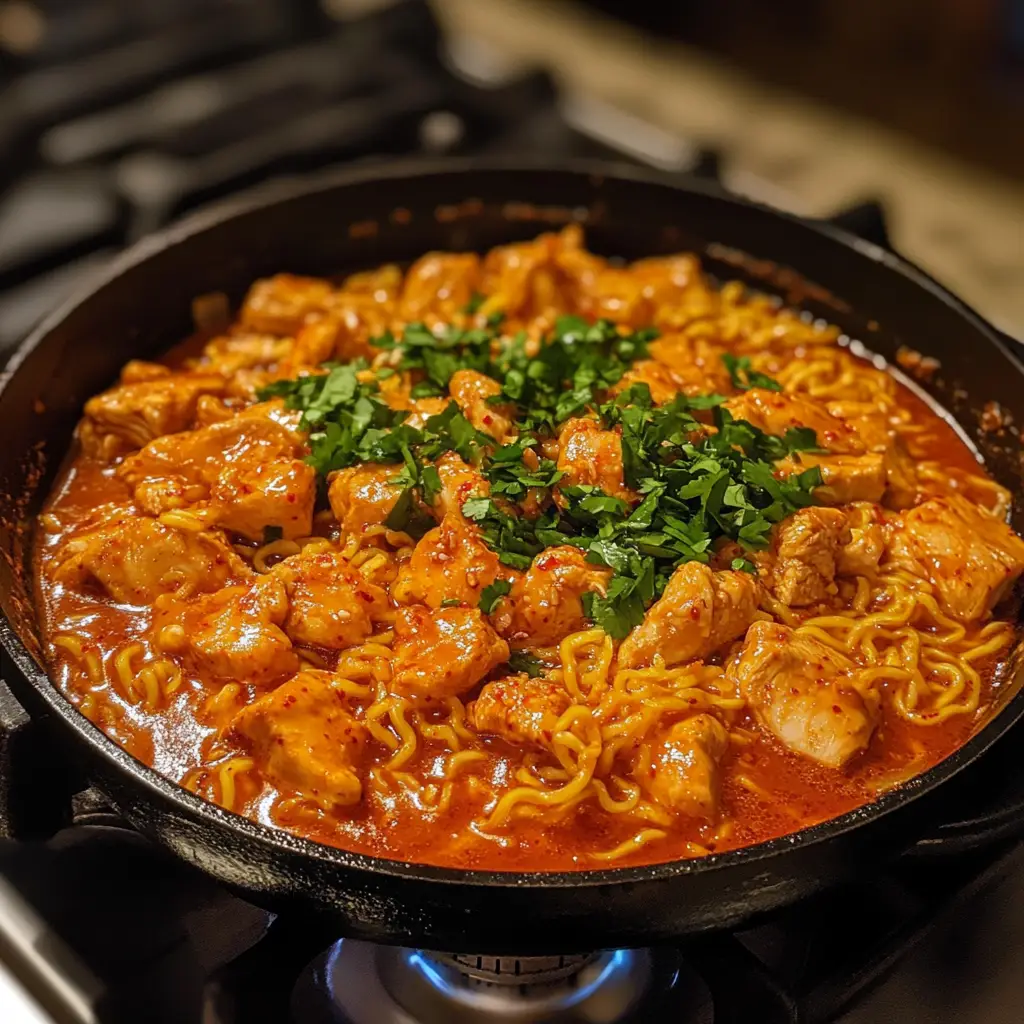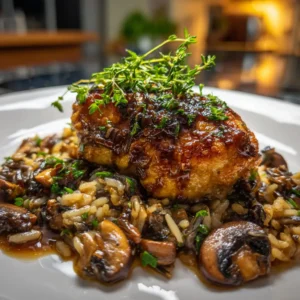Introduction to Korean Gochujang Chicken Ramen Recipe
As a passionate home cook, I often find myself on culinary adventures, exploring flavors from around the world. One dish that has captured my heart is the Korean Gochujang Chicken Ramen. The first time I tasted this delightful bowl of goodness, I was transported to a bustling street market in Seoul, where the air was filled with the tantalizing aroma of spicy, savory broth. It was love at first slurp!
Gochujang, a fermented Korean chili paste, is the star of this recipe. Its rich, umami flavor adds depth and warmth, making every bite a comforting experience. I remember the first time I decided to recreate this dish at home. I gathered my ingredients, excited to bring a piece of Korea into my kitchen. The vibrant colors of the vegetables, the tender chicken, and the steaming noodles all came together to create a feast for the senses.
What I love most about this recipe is its versatility. You can easily adjust the spice level to suit your taste, and it’s a fantastic way to use up leftover chicken or vegetables. Plus, it’s a one-bowl meal that’s perfect for cozy nights in or impressing friends at dinner parties. I often find myself making this dish when I need a little pick-me-up or when I want to share a taste of my culinary journey with others.
So, grab your apron and let’s dive into the world of Korean Gochujang Chicken Ramen! I promise you, this recipe will not only warm your belly but also your heart. Let’s get cooking!
Ingredients for Korean Gochujang Chicken Ramen Recipe
Before we embark on this delicious journey, let’s gather our ingredients. I always believe that the quality of your ingredients can make or break a dish. So, I recommend sourcing fresh, high-quality items whenever possible. Here’s what you’ll need for the Korean Gochujang Chicken Ramen:
Main Ingredients
- 2 boneless, skinless chicken thighs (about 1 pound) – I love using thighs for their juiciness, but you can use chicken breasts if you prefer.
- 4 cups chicken broth – Homemade is best, but store-bought works too. Look for low-sodium options to control the saltiness.
- 2 packs of ramen noodles – I usually go for fresh noodles, but dried ones are just fine.
- 2 tablespoons gochujang (Korean chili paste) – This is the heart of the dish! Make sure it’s a good quality brand for the best flavor.
- 1 tablespoon soy sauce – A splash of this adds a savory depth.
- 1 tablespoon sesame oil – This gives a lovely nutty aroma.
- 1 teaspoon minced garlic – Fresh garlic is a must for that aromatic kick.
- 1 teaspoon minced ginger – It adds a warm, zesty flavor that complements the dish beautifully.
- 1 cup sliced mushrooms – I prefer shiitake for their rich taste, but any mushrooms will do.
- 1 cup chopped bok choy or spinach – These greens add a pop of color and nutrition.
- 2 green onions, sliced – For garnish and a fresh crunch.
- 1 soft-boiled egg (optional) – This is a delightful addition that makes the dish feel extra special.
Optional Add-ons
- Chili flakes or fresh chili – If you like it spicy, feel free to add more heat!
- Toasted sesame seeds – A sprinkle on top adds a nice crunch.
- Seaweed sheets – For a touch of umami and a beautiful presentation.
- Other vegetables like carrots or bell peppers – Use whatever you have on hand to make it your own!
As I gather these ingredients, I can’t help but feel excited about the flavors that will soon come together. Each item plays a role in creating that perfect bowl of ramen. So, let’s get ready to cook up some magic!
How to Prepare Korean Gochujang Chicken Ramen Recipe
Now that we have our ingredients ready, it’s time to roll up our sleeves and get cooking! I find that the process of making Korean Gochujang Chicken Ramen is just as enjoyable as eating it. Each step brings its own excitement, and I can already smell the deliciousness in the air. Let’s dive into the preparation!
Step 1: Prepare the Chicken
First things first, we need to marinate our chicken. This step is crucial for infusing flavor into the meat. I usually start by cutting the chicken thighs into bite-sized pieces. This helps them cook evenly and soak up all that delicious marinade.
Tips for Marinating the Chicken
- Mix together 1 tablespoon of soy sauce, 1 tablespoon of sesame oil, and 1 teaspoon of minced garlic in a bowl. This combination creates a savory marinade that will make your chicken sing!
- Let the chicken marinate for at least 15 minutes. If you have more time, marinating for an hour or even overnight in the fridge will deepen the flavors.
- Don’t forget to reserve some marinade for later! It can be drizzled over the finished dish for an extra flavor boost.
Step 2: Cook the Noodles
While the chicken is marinating, it’s the perfect time to cook the noodles. I love the texture of ramen noodles, and getting them just right is key to a great bowl of ramen.
Tips for Perfectly Cooked Noodles
- Bring a pot of water to a rolling boil. Add the ramen noodles and cook according to the package instructions, usually about 3-4 minutes.
- To prevent the noodles from becoming mushy, I recommend tasting them a minute before the time is up. You want them al dente, with a slight bite!
- Once cooked, drain the noodles and rinse them under cold water to stop the cooking process. This keeps them from sticking together.
Step 3: Make the Gochujang Sauce
Now, let’s whip up the star of the show—the Gochujang sauce! This sauce is what gives our ramen its signature flavor. It’s spicy, savory, and oh-so-delicious!
Tips for Adjusting Spice Levels
- In a small bowl, combine 2 tablespoons of gochujang, the reserved marinade, and a splash of chicken broth. Mix until smooth.
- If you prefer a milder sauce, start with 1 tablespoon of gochujang and gradually add more to taste. You can always add more spice, but it’s hard to take it away!
- Feel free to add a teaspoon of sugar or honey to balance the heat if you find it too spicy.
Step 4: Combine Ingredients
With everything prepped, it’s time to bring our ramen together! This is where the magic happens, and I can hardly contain my excitement.
Tips for Layering Flavors
- In a large pot, heat a drizzle of sesame oil over medium heat. Add the marinated chicken and cook until browned and cooked through, about 5-7 minutes.
- Next, add the sliced mushrooms and cook for another 2-3 minutes until they soften.
- Pour in the chicken broth and bring it to a gentle simmer. Stir in the Gochujang sauce, and let it bubble away for a few minutes to meld the flavors.
- Finally, add the cooked noodles and greens, stirring gently to combine everything. Let it simmer for another minute to warm through.
And just like that, our Korean Gochujang Chicken Ramen is ready to be served! I can already feel the warmth and comfort radiating from this bowl. Let’s move on to the next steps to make this dish truly shine!
Equipment Needed for Korean Gochujang Chicken Ramen Recipe
Before we dive into the cooking process, let’s make sure we have all the right tools at our fingertips. Having the right equipment can make a world of difference in the kitchen. Here’s what you’ll need for our Korean Gochujang Chicken Ramen:
- Large Pot: A sturdy pot is essential for simmering the broth and cooking the chicken. If you don’t have a large pot, a deep skillet can work in a pinch.
- Cutting Board and Knife: A good cutting board and a sharp knife are must-haves for chopping the chicken and vegetables. I always keep my knife sharp; it makes prep work so much easier!
- Measuring Cups and Spoons: Accurate measurements are key to achieving the perfect balance of flavors. If you don’t have measuring cups, you can use a regular coffee mug as a rough guide.
- Mixing Bowls: A couple of mixing bowls will come in handy for marinating the chicken and mixing the Gochujang sauce. If you’re short on bowls, any container will do!
- Colander: This is useful for draining the noodles after cooking. If you don’t have one, you can use a slotted spoon to scoop them out instead.
- Whisk or Spoon: You’ll need something to mix the Gochujang sauce. A whisk is great, but a simple spoon works just as well.
With these tools in hand, you’re all set to create a delicious bowl of Korean Gochujang Chicken Ramen. I always find that having everything organized and ready to go makes the cooking process smoother and more enjoyable. Let’s keep the momentum going and get ready for the next steps!
Variations of Korean Gochujang Chicken Ramen Recipe
One of the things I adore about cooking is the freedom to experiment. The Korean Gochujang Chicken Ramen is no exception! There are countless ways to put your own spin on this dish, and I can’t wait to share a few of my favorite variations with you.
- Vegetarian Delight: Swap out the chicken for tofu or tempeh. Marinate the tofu just like you would the chicken for that same burst of flavor. Add extra veggies like bell peppers, zucchini, or snap peas for a colorful and nutritious bowl.
- Seafood Twist: If you’re a seafood lover, try adding shrimp or fish instead of chicken. Just toss them in during the last few minutes of cooking to keep them tender and juicy.
- Spicy Kimchi Ramen: For an extra kick, throw in some kimchi! It adds a tangy flavor that pairs beautifully with the Gochujang. You can even use kimchi broth instead of chicken broth for a deeper taste.
- Extra Creamy: If you’re in the mood for something rich, stir in a splash of coconut milk or a dollop of cream at the end. It creates a luscious, creamy broth that’s simply irresistible.
These variations not only keep things exciting but also allow you to cater to different dietary preferences. I love how a simple change can transform the dish into something new and delightful. So, don’t hesitate to get creative and make this recipe your own!
Cooking Notes for Korean Gochujang Chicken Ramen Recipe
As I dive into the world of Korean Gochujang Chicken Ramen, I’ve picked up a few cooking notes that can help elevate your dish. These little tips and tricks can make a big difference in the final outcome, ensuring that every bowl is bursting with flavor and comfort.
- Prep Ahead: If you’re short on time, consider prepping your ingredients in advance. Chop the vegetables and marinate the chicken the night before. This way, you can whip up your ramen in no time!
- Broth Matters: The broth is the backbone of your ramen. If you can, use homemade chicken broth for a richer flavor. If you’re using store-bought, opt for low-sodium to control the saltiness.
- Don’t Rush the Simmer: Allow the broth to simmer gently after adding the Gochujang sauce. This step helps the flavors meld together beautifully, creating a harmonious taste.
- Garnish Generously: Don’t skimp on the toppings! Fresh green onions, a soft-boiled egg, and a sprinkle of sesame seeds can take your ramen from good to extraordinary.
- Adjust to Taste: Everyone’s palate is different. Feel free to tweak the spice levels and seasoning to suit your preferences. Cooking is all about making it your own!
With these cooking notes in mind, you’re well on your way to creating a delicious bowl of Korean Gochujang Chicken Ramen. I always find that a little extra care in the kitchen goes a long way in making a meal truly special. Happy cooking!
Serving Suggestions for Korean Gochujang Chicken Ramen Recipe
Now that our Korean Gochujang Chicken Ramen is ready, it’s time to think about how to serve it up! Presentation can elevate the dining experience, and I love to make my bowls as inviting as possible. Here are some of my favorite serving suggestions that add a little flair to this comforting dish:
- Beautiful Bowls: Choose deep, wide bowls to showcase the vibrant colors of your ramen. The contrast of the rich broth against the bright greens and the golden egg makes for a stunning visual.
- Garnish Galore: Top each bowl with a generous sprinkle of sliced green onions, toasted sesame seeds, and a few chili flakes for an extra pop of color and flavor. If you have some fresh herbs like cilantro or basil, toss those in too!
- Side Dishes: Serve your ramen with a side of pickled vegetables or kimchi. The tangy crunch complements the rich broth beautifully and adds an extra layer of flavor.
- Chopsticks and Spoons: Don’t forget to provide chopsticks for slurping those noodles and a spoon for sipping the delicious broth. It’s all part of the experience!
- Pair with Drinks: A light, refreshing drink like iced green tea or a crisp lager can balance the spiciness of the ramen. If you’re feeling adventurous, try a Korean soju for a fun twist!
As I set the table, I can’t help but feel excited to share this dish with family and friends. The warmth of the ramen, combined with the thoughtful presentation, creates a cozy atmosphere that invites everyone to dig in. So, gather your loved ones, serve up those bowls, and enjoy the delightful flavors of your Korean Gochujang Chicken Ramen together!
Tips for Making Korean Gochujang Chicken Ramen Recipe
As I’ve journeyed through the delightful world of Korean Gochujang Chicken Ramen, I’ve gathered a few handy tips that can help you create the best bowl possible. These little nuggets of wisdom can make your cooking experience smoother and your ramen even more delicious!
- Use Fresh Ingredients: Fresh vegetables and high-quality chicken make a world of difference. I always opt for seasonal produce to enhance the flavors of my dish.
- Experiment with Broth: If you want to elevate your ramen, try adding a splash of miso or a few drops of fish sauce to the broth. It adds a depth of flavor that’s simply irresistible!
- Customize Your Spice: Don’t be afraid to adjust the amount of gochujang to suit your taste. I often start with less and add more as I go, ensuring it’s just right for my palate.
- Layer Your Ingredients: When combining everything, add the greens last to keep them vibrant and crisp. This way, they retain their color and nutrients, making your ramen not just tasty but also visually appealing.
- Let It Rest: After cooking, let your ramen sit for a minute before serving. This allows the flavors to meld together beautifully, creating a more harmonious dish.
With these tips in your back pocket, you’re all set to make a fantastic bowl of Korean Gochujang Chicken Ramen. Cooking is all about enjoying the process, so have fun and let your creativity shine through!
Breakdown of Time for Korean Gochujang Chicken Ramen Recipe
As I dive into the delicious world of Korean Gochujang Chicken Ramen, I often find myself curious about the time commitment involved. Knowing how long each step takes helps me plan my cooking sessions better. Here’s a quick breakdown of the time you’ll need to whip up this delightful dish:
- Prep Time: 20 minutes – This includes gathering your ingredients, marinating the chicken, and chopping the vegetables. I like to take my time here, enjoying the process of prepping everything just right.
- Cooking Time: 25 minutes – This is the time it takes to cook the chicken, noodles, and bring everything together in that beautiful broth. It’s a wonderful time to let the aromas fill your kitchen!
- Total Time: 45 minutes – In just under an hour, you can have a steaming bowl of Korean Gochujang Chicken Ramen ready to enjoy. Perfect for a cozy dinner or a fun gathering with friends!
With this time breakdown, you can easily fit this recipe into your busy schedule. I always find that knowing the timing helps me enjoy the cooking process even more. So, let’s get ready to savor every moment of making this delicious ramen!
Nutritional Information for Korean Gochujang Chicken Ramen Recipe
As a passionate home cook, I always pay attention to the nutritional value of the meals I prepare. It’s important to me that my dishes not only taste great but also nourish my body. Here’s a quick look at the nutritional information for a serving of Korean Gochujang Chicken Ramen:
- Calories: Approximately 450-500 calories per serving, depending on the specific ingredients used.
- Protein: About 30 grams, thanks to the chicken and any added tofu or eggs.
- Carbohydrates: Roughly 60 grams, primarily from the ramen noodles.
- Fat: Around 15 grams, mostly from the sesame oil and chicken.
- Fiber: Approximately 4-5 grams, depending on the vegetables added.
- Sodium: This can vary widely based on the broth and soy sauce used, but it’s wise to aim for a lower-sodium option to keep it healthier.
These numbers can change based on your ingredient choices and portion sizes. I often find that adding more vegetables can boost the fiber content while keeping the dish light and satisfying. Plus, it’s a great way to sneak in extra nutrients!
As I enjoy my bowl of Korean Gochujang Chicken Ramen, I feel good knowing that I’m indulging in a meal that’s not only delicious but also packed with wholesome ingredients. It’s all about balance, and this recipe hits the mark beautifully!
Frequently Asked Questions about Korean Gochujang Chicken Ramen Recipe
As I’ve shared my love for Korean Gochujang Chicken Ramen, I often get questions from fellow home cooks eager to try this delightful dish. It’s always exciting to see others dive into the world of flavors and spices! Here are some of the most common questions I receive, along with my answers to help you on your culinary journey.
Can I use other types of noodles?
Absolutely! While ramen noodles are traditional, you can use udon, soba, or even rice noodles if you prefer. Just keep in mind that cooking times may vary, so be sure to check the package instructions. I love experimenting with different noodles to see how they change the dish!
Is Gochujang very spicy?
Gochujang has a unique flavor profile that combines sweetness, spice, and umami. It’s not overwhelmingly spicy, but it does have a kick! If you’re sensitive to heat, start with a smaller amount and gradually add more to suit your taste. You can always balance the heat with a bit of sugar or honey.
Can I make this recipe vegetarian or vegan?
Yes, you can easily adapt this recipe! Swap the chicken for tofu or tempeh, and use vegetable broth instead of chicken broth. You can also add more vegetables to make it hearty and satisfying. It’s a great way to enjoy the flavors of ramen while keeping it plant-based!
How can I store leftovers?
If you have any leftovers (which is rare because it’s so delicious!), store them in an airtight container in the fridge for up to 3 days. When reheating, add a splash of broth or water to loosen the noodles and keep them from getting too dry. I find that the flavors often deepen overnight, making the leftovers even tastier!
What can I serve with Korean Gochujang Chicken Ramen?
This ramen is a complete meal on its own, but you can enhance your dining experience with some side dishes. I love serving it with pickled vegetables, kimchi, or a light salad. These sides add a refreshing contrast to the rich flavors of the ramen and make for a well-rounded meal.
With these FAQs, I hope to clear up any uncertainties you might have about making Korean Gochujang Chicken Ramen. Cooking is all about exploration and enjoyment, so don’t hesitate to ask questions and make this recipe your own. Happy cooking!
Conclusion on Korean Gochujang Chicken Ramen Recipe
As I reflect on my culinary journey with Korean Gochujang Chicken Ramen, I can’t help but feel a sense of warmth and satisfaction. This dish is more than just a meal; it’s a comforting embrace in a bowl. The rich flavors of the Gochujang, combined with tender chicken and fresh vegetables, create a symphony of taste that dances on the palate.
What I love most about this recipe is its versatility. Whether you’re looking for a quick weeknight dinner or a dish to impress friends, this ramen fits the bill perfectly. It’s a canvas for creativity, allowing you to customize it to your liking. Plus, it’s packed with nutrients, making it a wholesome choice for any occasion.
So, whether you’re a seasoned cook or just starting out, I encourage you to give this Korean Gochujang Chicken Ramen a try. It’s a delightful way to explore new flavors and bring a taste of Korea into your kitchen. I promise, each slurp will warm your heart and fill your belly with joy. Happy cooking, and may your ramen adventures be as delicious as mine!



